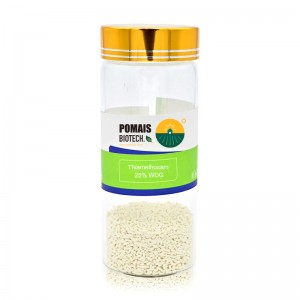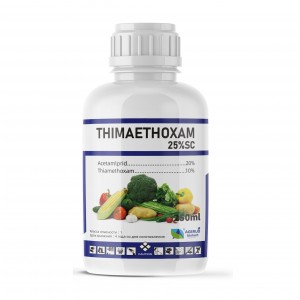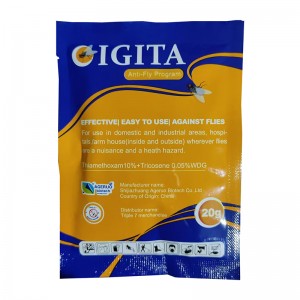Products
POMAIS Insecticide Thiamethoxam 25% 50% 75% WG (WDG)
Thiamethoxam is a neonicotinoid insecticide that is hotly touted for its effective control of a wide range of pests. It is designed to protect crops by targeting the nervous system of the insect, causing it to die. Thiamethoxam is a systemic insecticide and therefore can be absorbed by plants and provide long-lasting pest control protection.
Thiamethoxam 25% WG also known as Thiamethoxam 25% WDG are dispersible granules containing 25% Thiamethoxam per liter, in addition to this we also offer dispersible granules containing 50% and 75% per liter.
| Item | Detail |
|---|---|
| Active Ingredient | Thiamethoxam 25% WDG (water-dispersible granules, % w/w) |
| Chemical Class / IRAC | Neonicotinoid — IRAC Group 4A(nAChR competitive modulators) |
| CAS Number | 153719-23-4 |
| Core Value | Systemic movement into new growth; contact + ingestion activity;fast feeding cessation |
| Primary Targets | Aphids, whiteflies, leafhoppers, thrips(label-dependent) |
| Use Sites | Field & protected crops where registered(verify crops/REI/PHI on local label) |
| Formulation Benefits | Low-dust, free-flowing granules; disperse rapidly to stable spray suspensions |
| Packaging & OEM | 250 g / 1 kg bags;multilingual GHS private label;lot-level barcoding/QR |
| Documents | COA / MSDS (SDS) / TDS provided with each lot |
Mode of Action — IRAC 4A
Thiamethoxam belongs to the neonicotinoid class (IRAC Group 4A) that targets the insect nicotinic acetylcholine receptor (nAChR). By acting as a receptor agonist/modulator at nAChRs in the insect nervous system, it rapidly stops feeding, then drives neuromuscular failure leading to knockdown and death. Because thiamethoxam is systemic, it moves with plant fluids and protects new growth, supporting both ingestion (sap feeding) and contact exposure routes—an advantage against aphids, whiteflies, leafhoppers, and thrips when labels allow. For stewardship, integrate MoA rotations with non-4A chemistries to slow resistance development; IRAC recommends alternating MoA groups across spray windows rather than treating successive generations with the same MoA.
Formulation Advantages — WDG
-
Low-dust, free-flowing granules
Water-dispersible granules are designed to be dry, free-flowing and essentially non-dusty, reducing operator dust exposure versus legacy wettable powders and improving handling in warehouses and at the spray rig. That description comes directly from FAO/WHO formulation guidance for WG/WDG.
-
Fast disintegration → stable spray suspensions
WDGs are engineered to break down rapidly in water and disperse into a fine, uniform suspension that stays mixed with standard agitation—key for dose uniformity across the boom. CIPAC’s MT 174 method specifically assesses how readily a WG/WDG disperses; high top-fraction recovery indicates good field performance.
-
Clean measuring & tank hygiene
As a solid, non-dusty format, WDGs support accurate weighing, less caking, and tidier loading compared with solvented liquids or dusty powders. Industry summaries align with FAO/WHO principles and emphasize user handling and dispersion benefits.
-
Predictable quality controls
FAO/WHO and EU technical guidance specify the physical–chemical properties WG/WDG products must meet before and after storage (e.g., wet sieve, suspensibility/dispersion, attrition, storage stability), giving buyers a clear benchmark for batch release and shelf behavior. OECD provides the complementary storage-stability framework used in registrations.
-
Program fit across equipment & sites
Because WDGs are diluted in water at point of use, they integrate with common spray equipment and SOPs; OECD notes WGs among the most common water-dilutable types used in crop applications—useful for multi-site distributors standardizing training. All operational details remain label-led.
Target Pests & Crop Fit
Built for sucking-pest complexes. Thiamethoxam 25% WDG targets aphids, whiteflies, leafhoppers, and thrips with systemic movement and contact + ingestion activity; these are the core pest groups repeatedly listed across major labels and regulatory summaries. Always confirm your locally registered spectrum on the approved label.
Crop groups where thiamethoxam is commonly registered (examples; label-dependent):
-
Field & specialty crops: root/tuber vegetables, leafy vegetables (brassica & non-brassica), legumes, fruiting vegetables (tomato/pepper/eggplant), cucurbits, and cereals/oilseeds—reflecting wide agricultural use sites in U.S. EPA reviews.
-
Protected & ornamental production: greenhouses, nurseries, ornamentals (shrubs, flowering/foliage plants, non-bearing fruit/nut trees) via thiamethoxam 25WG labels for aphids, whiteflies, leafminers, thrips where permitted.
Program fit. Because the AI is IRAC 4A (neonicotinoid) with strong systemicity, it’s typically positioned for sap-feeding pest suppression on both open-field and protected crops; use in rotation with non-4A modes to sustain performance, and observe any pollinator/bloom restrictions specified by local labels.
Use Principles — Label-Led, Market-Ready
-
Follow the approved label first. Crops, pests, timings, interval caps, PHI/REI, buffer zones, and region-specific restrictions are jurisdiction-dependent. Always align applications, re-treat windows, and maximum seasonal limits with the current approved label/SDS.
-
Respect pollinator protections. Thiamethoxam (a Group 4A neonicotinoid) is regulated for bee/pollinator risk in several markets; the EPA registration-review and related updates maintain risk-mitigation measures, and the EU has imposed strict outdoor-use prohibitions. Observe label statements on bloom-time restrictions, foraging windows, and site controls.
-
Protected crops & ornamentals: label governs. Where registered, thiamethoxam allows greenhouse/nursery use and crop-specific methods. Validate permitted use sites, application methods, and plant safety; conduct small-scale checks when mixing with other products.
-
Compatibility comes before convenience. Perform a jar test per label/SDS before tank mixes, follow the mixing order and pH envelope, and avoid conditions the label flags (e.g., certain alkaline mixtures). Only use label-permitted adjuvants suitable for the crop/phenology.
-
Worker safety & site stewardship. Enforce PPE, signage, re-entry intervals (REI), and storage/transport controls from the SDS. Manage drift and aquatic buffers per local rules. Keep detailed application records (lot IDs, field/zone, crop stage, conditions) to support audits.
-
Resistance-aware scheduling. Integrate IRAC 4A within a seasonal plan that alternates/rotates with non-Group 4 modes and uses IPM thresholds. Avoid back-to-back 4A applications across generations when the label provides alternatives.
Use Principles — Label-Led
-
Follow the approved label: Use only as directed on your local registration; labels govern crops, pests, timings, PHI/REI, application methods, buffer zones, and any restrictions.
-
Worker protection: Observe the Restricted-Entry Interval (REI) stated on the label (e.g., a 12-hour REI appears on comparable 25% WG/WDG labels); ensure label-required PPE during mixing/loading and application.
-
Pollinator stewardship: Where applicable, avoid spraying when bees/beneficials are active and follow crop-specific timing guidance (greenhouse and outdoor); comply with any bloom-time or site-specific pollinator protections.
-
Drift & buffers: Minimize drift (consider wind, temperature, equipment, sprayer settings) and respect aquatic/terrestrial buffer zones. For tank mixes, apply the most restrictive buffer among products used.
-
Tank-mix compatibility: Conduct a jar-test/compatibility check as permitted; confirm pH and order-of-mixing per each partner’s label/SDS; never exceed any partner’s label limits.
-
Storage & disposal: Store cool, dry, away from food/feed; follow label/SDS for container handling and disposal pathways (recyclable/returnable/refillable where indicated).
-
Documentation & traceability: Keep application logs (field, crop stage, date/time, lot ID) and maintain COA/SDS/TDS on file to support audits and distributor onboarding. (Good practice aligned with label-led programs.)
-
Regulatory changes: Some jurisdictions periodically update neonicotinoid risk-mitigation measures (pollinator actions, use-site limitations, review timelines). Verify the latest EPA/EU updates before commercialization.
Resistance Management
-
Alternate MoA groups across spray windows. Build a season plan that rotates away from IRAC 4A to non-4 chemistries so successive generations are not exposed to the same target site. Use spray “windows/blocks” aligned to crop stage and pest biology.
-
Limit consecutive 4A exposures. Avoid back-to-back applications from the same MoA; leave sufficient intervals before any return to 4A to minimize selection pressure.
-
Design rotations by efficacy + distinct MoA. Choose only effective actives from different groups; do not “rotate brand names”—rotate active ingredients/MoA groups.
-
Integrate IPM. Use thresholds, scouting, and cultural controls to reduce spray frequency and delay resistance. Coordinate with regional advisors.
-
Document and audit. Log field, growth stage, pest pressure, date, lot ID, MoA group for each application; review outcomes post-season to refine rotations. Regulatory reviewers (e.g., EPA PIDs) reinforce adding resistance-management language to labels.
Pollinator & Non-Target Stewardship
-
Bee precautions are non-negotiable. Thiamethoxam is highly toxic to bees; many labels direct no applications to blooming crops/weeds or when bees are actively foraging, and require removal/mowing of flowering groundcover before spray. Follow local label language precisely.
-
Know your market’s red lines. The EU prohibited all outdoor uses of thiamethoxam in 2018; uses are generally limited to permanent greenhouses, with some member states granting time-bound emergency authorizations (e.g., sugar beet). Buyers must verify allowed sites before commercialization.
-
Scientific basis for restrictions. EFSA’s 2018 bee risk reviews concluded high risks to honey bees and wild bees for neonicotinoids, underpinning EU measures and ongoing stewardship worldwide.
-
U.S. stewardship is evolving. EPA’s neonicotinoid registration reviews remain active with proposed interim decisions and updated risk-mitigation timelines; always check the latest federal/state guidance before setting programs.
-
Practical guardrails (label-led).
-
Avoid treatment during bloom or when managed pollinators/beneficials are present; respect buffer zones.
-
Coordinate with growers and beekeepers on application timing, greenhouse ventilation, and entry intervals.
-
Integrate non-chemical controls and IRAC-diverse rotations to reduce application frequency and exposure.
-
Environmental & HSE
Worker safety. Treat Thiamethoxam 25% WDG as a combustible powder; avoid dust clouds and ignition sources. Use label-required PPE (chemical-resistant gloves, goggles, protective clothing) and keep good hygiene (no eating/drinking during handling). SDS data for 25WG/WDG products confirm combustible dust, typical PPE, and inhalation controls. Stable under normal storage, with product-level pH ~9.4 (1% dispersion) referenced in SDS. Dispose of containers per local rules and the label.
Environmental transport & fate. Many SDS documents classify thiamethoxam formulations as UN 3077, Class 9 “Environmentally Hazardous Substance, Solid, N.O.S.” for water/air transport, signaling aquatic risk; follow label buffer zones and avoid drift/runoff to water. Ecotoxicity/fate sections for thiamethoxam note moderate soil mobility and stability in water—further reason to enforce buffers, avoid bloom, and follow label disposal instructions.
Quality & Stability
QC benchmarks. WDG lots should meet FAO/WHO & EU guidance for dispersibility/suspensibility, attrition resistance, storage stability, wet sieve and related physicochemical endpoints. CIPAC MT 174 is the standard method used to verify WDG dispersibility (uniform top-fraction recovery).
On-product stability signals. Thiamethoxam 25WG SDS typically reports “stable under normal use and storage conditions,” with product-level data (e.g., pH ≈ 9.4 @ 1%, bulk density) to support shelf behavior and formulation integrity in distribution. Use first-in-first-out, dry/cool storage, and close bags tightly after partial use.
Packaging & OEM
Pack formats. 250 g / 500 g / 1 kg foil bags(multi-wall options)or customized as needed; export cartons with moisture control and pallet plans for sea/air.
Compliance-ready labels. We build multilingual labels aligned to GHS and regional hazard communication: signal word, pictograms, hazard & precautionary statements, product identifier, responsible party. Align with UNECE GHS framework and local implementations (e.g., OSHA HazCom 1910.1200 in the U.S.).
Documentation bundle. Per shipment/lot: COA, SDS, TDS, and barcode/QR for traceability. We can mirror your distributor SKU conventions and add language packs (EN/ES/FR/AR/RU). (Documentation elements reflect GHS/HazCom label–SDS pairing best practices.)
Regulatory Landscape
-
EU: All outdoor uses of imidacloprid, clothianidin, thiamethoxam were prohibited in 2018; subsequent measures tightened MRLs. Greenhouse-only scenarios and time-bound emergency authorizations exist in some member states—check current approvals.
-
Bee-risk basis: EFSA (2018) concluded high risks to honey bees and wild bees from the three neonicotinoids, underpinning EU actions and ongoing stewardship globally.
-
U.S.: EPA issued Proposed Interim Decisions (PIDs) in 2020 for clothianidin/thiamethoxam and maintains a live review schedule; amended PIDs/interim decisions are anticipated in 2025. Always verify the latest docket before commercialization.
FAQ
Q1: Can I rotate this with other neonicotinoids?
No. Rotation means switching Mode of Action (MoA) groups. Thiamethoxam is IRAC 4A; rotate to non-4 groups per IRAC guidance.
Q2: Is it allowed in greenhouses where outdoor use is restricted?
That depends on country-specific approvals. In the EU, outdoor uses are prohibited since 2018; some greenhouse uses and emergency authorizations may exist—verify national status.
Q3: What label elements must my private-label include?
Follow GHS/HazCom: signal word, pictograms, hazard statements, precautionary statements, product identifier, responsible party. We supply templates aligned to UNECE GHS and OSHA HazCom.
Q4: What quality tests should my QC request before release?
Ask for CIPAC MT 174 dispersibility, suspensibility, wet sieve, attrition, and storage-stability data per FAO/WHO/SANCO guidance.
Q5: Any headline HSE items for warehouse SOPs?
Treat WDG as combustible powder; manage dust; keep away from ignition; follow PPE on the label/SDS; respect buffer zones and disposal instructions.
Partner with POMAIS
You get compliant labels, documentation pack (COA/SDS/TDS), language localization, and export-grade packaging matched to your routes. Our formulation and QC teams align to FAO/WHO & CIPAC expectations so your brand ships with confidence. (All uses are label-led; verify local approvals before commercialization.)
|
Product |
crops |
insects |
dosage |
|
Thiamethoxam 25%WDG |
Rice |
Rice fulgorid Leafhoppers |
30-50g/ha |
|
Wheat |
Aphids Thrips |
120g-150g/ha |
|
|
Tobacco |
Aphid |
60-120g/ha |
|
|
Fruit trees |
Aphid Blind bug |
8000-12000times liquid |
|
|
Vegetable |
Aphids Thrips Whiteflies |
60-120g/ha |
(1) Do not mix Thiamethoxam with alkaline agents.
(2) Do not store the thiamethoxam in environments with the temperature below 10°C or above 35°C.
(3) Thiamethoxam is toxic to bees, special care should be taken when using it.
(4) The insecticidal activity of this drug is very high, so do not blindly increase the dosage when using it.











